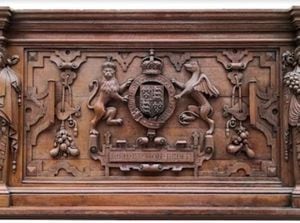Court action to stop sale of Tudor artefact expected to be worth millions is dropped
Court action to stop the sale of a Tudor artefact has been dropped by Stafford Borough Council.

The authority took legal action after an oak overmantle was removed from Seighford Hall and put up for sale.
The artefact, which bears Queen Elizabeth I’s coat of arms, was expected to fetch between £1.9 million and £5 million at a sale organised by Whitchurch Auctions in the summer.
But Stafford Borough Council applied for an injunction, claiming the artefact was removed without consent and should be reinstated at the hall.
Andrew Potter, who acquired the overmantle from Seighford Hall, was told at a Birmingham County Court hearing in September he must inform Stafford Borough Council where it was being stored and allow it to be inspected by the authority. The case was adjourned until a later date.
But the matter is now not proceeding to a full injunction.
Stafford Borough Council spokesman Will Conaghan said: “A judge granted us an interim injunction so we could prevent a criminal offence being committed.
“The overmantle was removed from Seighford Hall without proper listed building consent. This makes it a ‘tainted cultural object’ in law.
“All parties are now aware that to sell it would be an offence so there is no longer a need for us to pursue a full injunction through the courts.”
Michael Jones from Whitchurch Auctions said there had been no wrongdoing involved in the acquisition of the overmantle by its owner, who was unaware of its value at first.
Mr Potter, who lives in Stafford, had planned to turn the heavy overmantle, which is almost 9ft wide, into a headboard.
The auctioneer said it was infested with woodworm and due to be burnt before it was acquired by Mr Potter and later stored in a garage for several months, where it dried out.
Seighford Hall, a Grade II Listed building, is believed to have been gifted by Elizabeth I to Richard Eld in the 1590s as a reward for his services as paymaster.
In the 20th century Seighford Hall was used as a nursing home but it is now set to be transformed into a luxury hotel.
The overmantle was displayed over a fireplace at the hall and is believed to be between 417 and 462 years old. It features a lion and dragon, representing England and Wales, supporting a shield in the centre.
There are also carvings depicting lyres and hanging fruit, as well as atlas and caryatid (male and female) figures, and the overmantle is considered to be influenced by architects and designers from France and Italy.





